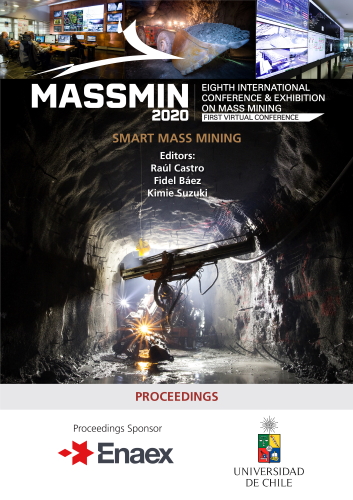Incorporating vulnerability of hang-ups and secondary breaking to drawpoints availability for short-term cave plans, El Teniente mine

|
Authors: Garces, D; Rebolledo, H; Miranda, P |
This paper is hosted with the kind permission of Lulea University of Technology, International Conference & Exhibition on Mass Mining, 2024.
DOI https://doi.org/10.36487/ACG_repo/2063_71
Cite As:
Garces, D, Rebolledo, H & Miranda, P 2020, 'Incorporating vulnerability of hang-ups and secondary breaking to drawpoints availability for short-term cave plans, El Teniente mine', in R Castro, F Báez & K Suzuki (eds), MassMin 2020: Proceedings of the Eighth International Conference & Exhibition on Mass Mining, University of Chile, Santiago, pp. 988-1001, https://doi.org/10.36487/ACG_repo/2063_71
Abstract:
Block and panel caving are increasingly considered as suitable massive underground methods for mining large, deep and competent orebodies. Currently, one of the main challenges in cave mines is the compliance to high daily production rates without putting aside cave management measures. This is a crucial cave concept to incorporate into short-term planning since a lack of cave management may cause significant issues in geomechanics, caving initiation and propagation, cave flow and incorporation rate. This paper focuses on developing a methodology to estimate drawpoint availability uncertainty taking into account hang-up frequency and secondary breaking as key operational variables for short-term planning. Mine data regarding daily draw, hang-ups at drawpoints and secondary breakage activities are gathered from El Teniente mine to determine probability distribution functions of each studied variable. These probability distributions are combined with Monte Carlo simulation for assessing monthly cave productions at the study area. The results obtained herein are of great importance since this method provides a measure of the monthly production compliance. Moreover, the research allows for the identification of drawpoints prone to low availability, in where planned decisions and operational effort may lead to mitigating vulnerabilities of cave production plans.
References:
Brzovic, A, Vallejos, J, Arancibia, E, Burgos, L, Delonca, A, Gaete, M & Barrera, V 2016, ‘Analysis and modelling of the fragmentation process – Case studies at El Teniente mine’, in C Carr & G Chitombo (eds), Proceedings of MassMin 2016, Sydney, pp. 305-310.
Brzovic, A & Schachter, P 2013, ‘Rock mass geotechnical characterization based on the weak stockwork veins at the El Teniente Mine’, in Proceedings of the Third International Seminar on Geology for the Mining Industry, Santiago.
Brzovic, A & Villaescusa, E 2007, ‘Rock mass characterization and assessment of block-forming geological discontinuities during caving of primary copper ore at the El Teniente Mine, Chile’, International Journal of Rock Mechanics and Mining Sciences, vol. 44, no. 4, pp. 565-583.
Castro, R, Gómez, R & Hekmat, A 2016, ‘Experimental quantification of hang-up for block caving applications’, International Journal of Rock Mechanics & Mining Sciences, vol. 85, pp. 1-9.
Chitombo, GP 2010, ‘Cave mining – 16 years after Laubscher’s 1994 paper ‘Cave mining – state of the art’’, in Proceedings of the Second International Symposium on Block and Sublevel Caving, ed. Y. Potvin, ACG, Perth, pp. 45-61.
Dershowitz, WS & Einstein HH 1988, ‘Characterizing rock joint geometry with joint system models’, Rock Mechanics and Rock Engineering, Vol. 21, no. 1, pp. 21-51.
Dirkx, R, Kazakidis, V & Dimitrakopoulos, R 2019, ‘Stochastic optimisation of long-term block cave scheduling with hang-up and grade uncertainty’, International Journal of Mining, Reclamation and Environment, vol. 33, no. 6, pp. 371-388.
Laubscher, DH 1994, ‘Cave mining – the state of the art’, The Journal of The South African Institute of Mining and Metallurgy, pp. 279-293.
Ngidi, S & Boshoff, P 2011, ‘Cave management and secondary breaking practices at Palabora Mining Company’, in Proceeding of The Sixth Southern African Base Metals conference, SAIMM, Phalaborwa, pp. 209-220.
Ngidi, SN & Pretorius, DD 2011, ‘Impact of poor fragmentation on cave management’, in Proceeding of The Sixth Southern African Base Metals conference, SAIMM, Phalaborwa, pp. 111-121.
Ngidi, S & Boshoff, P 2007, ‘Cave management and secondary breaking practices at Palabora Mining Company’, The Journal of The South African Institute of Mining and Metallurgy, pp. 783-789.
Rubio E & Troncoso S 2008, ‘Discrete events simulation to integrate operational interruption events in block cave production scheduling’, in Third International Conference on Mining Innovation, Santiago.
Rubio, E & Dunbar, WS 2005, ‘Integrating uncertainty in block cave production scheduling’, in Proceedings of the 32nd International Symposium on the Application of Computers and Operations Research in the Mineral Industry (APCOM), ed. S. Dessureault, R. Ganguli, V. Kecojevic, J. Girard-Dwyer, Tucson, pp. 635-642.
Viera, E & Diez E 2014, ‘Analysis of hangup frequency in Bloque 1-2, Esmeralda Sur mine’, in Proceedings of the Third International Symposium on Block and Sublevel Caving, ed. R. Castro, University of Chile, Santiago, pp. 138-145.
© Copyright 2025, Australian Centre for Geomechanics (ACG), The University of Western Australia. All rights reserved.
View copyright/legal information
Please direct any queries or error reports to repository-acg@uwa.edu.au
View copyright/legal information
Please direct any queries or error reports to repository-acg@uwa.edu.au
